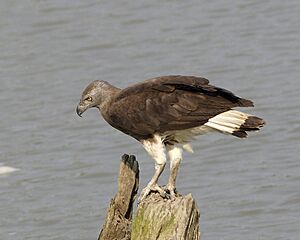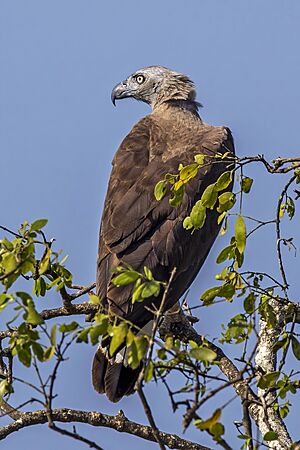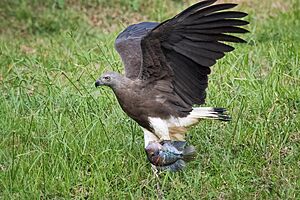Grey-headed fish eagle facts for kids
Quick facts for kids Grey-headed fish eagle |
|
|---|---|
 |
|
| Conservation status | |
| Scientific classification | |
| Genus: |
Icthyophaga
|
| Species: |
ichthyaetus
|
| Synonyms | |
|
|

The grey-headed fish eagle (Icthyophaga ichthyaetus) is a powerful bird of prey that loves to eat fish. It lives in Southeast Asia. This large bird has a dark brown body, a grey head, and a lighter belly with white legs. Young eagles are usually paler with dark streaks. People sometimes confuse it with the lesser fish eagle or the Pallas's fish eagle. The lesser fish eagle looks similar but is smaller. The Pallas's fish eagle lives in the same places and eats fish too, but it is larger with longer wings and darker underparts. In Sri Lanka, this eagle is often called the "tank eagle" because it loves to hunt near irrigation tanks (like large ponds or small lakes).
Contents
About the Grey-headed Fish Eagle
What Kind of Bird Is It?
The grey-headed fish eagle belongs to a group of birds called Accipitriformes. This group includes most birds of prey, like hawks and true eagles, but not ospreys or falcons. Scientists sometimes place this eagle in its own special group called Ichthyophaga.
How to Spot a Grey-headed Fish Eagle
This eagle is a medium-sized but strong bird. It has a small beak and head, a long neck, and a rounded tail. Its legs are short and do not have feathers, and its talons (claws) are long. Its wings are not super long, and the tips don't reach far down its tail.
Male and female eagles look a bit different in size. Females are heavier, weighing about 2.3 to 2.7 kilograms (5 to 6 pounds). Males are lighter, around 1.6 kilograms (3.5 pounds). These eagles are usually 61 to 75 centimeters (24 to 30 inches) long. Their wingspan can be quite wide, from 155 to 170 centimeters (about 5 to 5.5 feet).
Adult Eagles
Adult grey-headed fish eagles are grey-brown. They have a pale grey head and light-colored eyes. Their belly and tail are white. The tail has a wide black band near the end. Their chest and neck are brown, and their wings are dark brown on top with blacker tips.
Young Eagles
Young eagles have brown heads and necks, with some white streaks. Their upper body is darker brown. Their tail is a mix of black and white, with a wider dark band and a white tip. Their belly and thighs are white, while their chest is brown with white streaks. As they grow up, their head becomes greyer, and the dark band on their tail becomes clearer.
Where They Live
Distribution and Habitat
The grey-headed fish eagle lives across a large area, from India and Southeast Asia to Malaysia, Indonesia, and the Philippines. It is not very common everywhere, and in some places, it is quite rare. You can find it in parts of North and East India, Sri Lanka, Nepal, Bangladesh, Thailand, Laos, Vietnam, Cambodia, Malaysia, Sumatra, Borneo, and the Philippines.
Preferred Homes
These eagles live in lowland forests, sometimes up to 1,500 meters (about 4,900 feet) above sea level. They build their nests close to water, like slow-moving rivers, streams, lakes, and swamps. They also like coastal lagoons and estuaries (where rivers meet the sea). As mentioned before, they often visit irrigation tanks in Sri Lanka.
How They Live
Daily Life and Behavior
The grey-headed fish eagle usually stays in one place and does not migrate (travel long distances). It can be seen alone or in pairs. Young eagles might fly away from their birth areas to find a mate or new food sources.
These eagles spend a lot of time sitting upright on bare branches that hang over water. From there, they watch for fish. When they fly, their wingbeats are strong and full, and their wings are held somewhat flat. They don't spend much time soaring high in the sky.
Reproduction and Life Cycle
The breeding season for these eagles usually happens between November and May in most places. However, it can change depending on the country. For example, in Sri Lanka, it's from December to March, and in India, it's November to January.
Nests
Grey-headed fish eagles build very large stick nests. These nests can be up to 1.5 meters (5 feet) wide and, if used many times, up to 2 meters (6.5 feet) deep! They line their nests with green leaves. They build them in tall trees (8 to 30 meters or 26 to 98 feet high) that have an open top. These trees can be in a forest or standing alone. Nests are always near water and away from human homes.
Eggs and Young
A pair of eagles usually lays two unmarked white eggs, but sometimes they can lay between two and four. Both the male and female eagles share the job of incubating (sitting on) the eggs, finding food, and feeding the young. The eggs hatch after about 45 to 50 days. The young eagles stay in the nest for about 70 days before they are ready to fly.
What They Eat and How They Hunt
As their name suggests, grey-headed fish eagles mainly eat fish. They hunt live fish but will also eat dead fish. Sometimes, they might eat reptiles, other birds, or small mammals.
Their most common way of hunting is to sit on a branch near water. Then, they fly down quickly to snatch fish from the water's surface or just below it. They can also fly over rivers or lakes, looking for prey. If a fish is too heavy to carry, they might drag it to the bank to eat it. They are even good at catching fish in rough water, like rapids! Both types of fish eagles in the Ichthyophaga group have strongly curved talons, just like the osprey. This special claw shape helps them catch slippery fish.
Their Calls
The grey-headed fish eagle makes several different sounds. Some calls include a gurgling "awh-awhr" and "chee-warr" repeated many times. They also make an owl-like "ooo-wok" sound and a loud, high-pitched scream. These calls can start soft and then get louder and sharper before fading away. They make these sounds from a perch or while flying. Young eagles make a longer, nasal "uuuw-whaar" sound that starts low and then gets louder. During the breeding season, they become very noisy, and their calls can be heard far away, even at night.
Threats to Their Survival
Even though the grey-headed fish eagle is not yet considered to be in danger of extinction, its numbers are going down. Many things are causing this decline:
- Loss of wetlands: They are losing the watery places they need to live.
- Deforestation: Forests where they nest are being cut down.
- Over-fishing: There aren't enough fish for them to eat because too many are caught by people.
- Pollution: Water pollution can harm fish and the eagles that eat them.
- Human disturbance: People being too close to their nests can scare them away.
- Dams: Building dams on rivers like the Mekong River can change the natural floods that are important for the areas where these eagles live.
Protecting the Grey-headed Fish Eagle
Conservation Status
The grey-headed fish eagle is currently listed as "Near-Threatened" on the IUCN Red List. This means that while it's not in immediate danger, its population is declining, and it could become threatened soon. Scientists believe there are likely between 10,000 and 100,000 adult eagles left. However, because their numbers are dropping quickly, the actual number might be closer to 10,000, which would put them closer to being "Vulnerable."
What Is Being Done?
While there are no big conservation plans just for this eagle, there is a yearly program that watches the breeding eagles at the Prek Toal protected area in Cambodia. This program helps scientists learn more about the eagles and how many there are.
The IUCN (International Union for Conservation of Nature) has suggested some ways to help these eagles:
- Surveys: Find out where the most important areas for the eagles are and check on them regularly.
- Protect forests: Keep forests safe in areas where the eagles live.
- Awareness campaigns: Teach local people about the eagles and encourage them to take better care of wetland areas.



